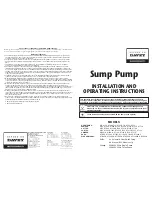
14
We recommend to protect all other motors against voltage peaks
higher than 1200 V by 2000 V/µsec.
The above disturbances, i.e. both increased acoustic noise and
detrimental voltage peaks, can be eliminated by fitting an LC filter
between the frequency converter and the motor.
For further information, please contact the frequency converter or
motor supplier.
Other motor makes than those supplied by Grundfos
Please contact the motor manufacturer.
10. Start-up
10.1 Start-up procedure
1. Make sure the power supply is switched off.
2. Check to make sure the pump has been primed. See
procedure below.
Priming procedure
To prime the pump in a closed system or an open system where
the water source is above the pump, proceed as follows:
•
Close the pump isolation valve(s), and open the priming plug
on the pump head.
•
Gradually open the isolation valve in the suction pipe until a
steady stream of airless water runs out the priming port.
•
Close the priming plug and securely tighten. Completely open
the isolation valves.
In open systems where the water level is below the pump inlet,
the suction pipe and pump must be filled and vented of air before
starting the pump.
•
Close the discharge isolation valve, and remove the priming
plug.
•
Pour water through the priming hole until the suction pipe and
pump are completely filled with water. If the suction pipe does
not slope downwards away from the pump towards the water
level, the air must be purged while being filled.
•
Replace the priming plug and securely tighten.
For pumps with air-cooled top, see page 17.
For all systems, proceed as follows:
3. Remove the coupling guard, and rotate the pump shaft by
hand to be certain it turns freely.
4. Verify that the electrical connections are in accordance with
the wiring diagram on the motor.
5. Switch on the power supply momentarily and observe the
direction of rotation. When viewed from the motor end, the
pump should rotate counter-clockwise.
6. To reverse the direction of rotation, first switch
off
the power
supply.
7. On three-phase motors, interchange any two power leads at
the load side of the starter.
On single-phase motors, see wiring diagram on the
nameplate. Change wiring as required.
8. Switch on the power supply, and again check for proper motor
rotation. Once rotation has been verified, switch off the power
supply again.
9. Do not attempt to refit the coupling guards with the motor
energized. Replace the coupling guard if the rotation is
correct. After the guards are in place, the power supply can be
switched on again.
Operating parameters
CR multistage centrifugal pumps installed in accordance with
these instructions and sized for correct performance will operate
efficiently and provide years of service.
The pumps are water-lubricated and do not require any external
lubrication or inspection.
The motors may require periodic lubrication as noted in section
11. Maintenance
.
Under no circumstances should the pump be operated for any
prolonged periods of time without flow through the pump. This
can result in motor and pump damage due to overheating.
A properly sized relief valve should be installed to allow sufficient
water to circulate through the pump to provide adequate cooling
and lubrication of the pump bearings and seals.
Pump cycling
Pump cycling should be checked to ensure the pump is not
starting more often than stated in the table in section
7.2 Frequency of starts and stops
.
Rapid cycling is a major cause of premature motor failure due to
increased heat build-up in the motor. If necessary, adjust
controllers to reduce the frequency of starts and stops.
11. Maintenance
Pump bearings and shaft seal are maintenance-free.
11.1 Motor inspection
Inspect the motor at regular intervals, approximately every
500 hours of operation or every three months, whichever occurs
first. Keep the motor clean and the ventilation openings clear.
The following steps should be performed at each inspection:
Caution
Do not start the pump until it has been filled with
liquid and vented. If the pump runs dry, the pump
bearings and the shaft seal may be damaged.
Warning
Pay attention to the direction of the vent hole, and
take care to ensure that the escaping water does
not cause injury to persons or damage to the
motor or other components.
In hot-water installations, pay special attention to
the risk of injury caused by scalding hot water.
Caution
Do not start the pump before priming or venting
the pump (step 2).
Never operate the pump dry.
Note
Motors should not be run unloaded or uncoupled
from the pump at any time. Damage to the motor
bearings may occur.
Warning
Before starting work on the pump, make sure that
all power supplies to the pump have been
switched off and that they cannot be accidentally
switched on.
Warning
Do not touch electrical connections before you
first ensure that the power supply has been
disconnected.
Electrical shock can cause serious or fatal injury.
Only qualified personnel should attempt
installation, operation and maintenance of this
equipment.
Summary of Contents for CR-H
Page 1: ...CR H CRN H GRUNDFOS INSTRUCTIONS Installation and operating instructions ...
Page 2: ...2 ...
Page 62: ...62 ...















































